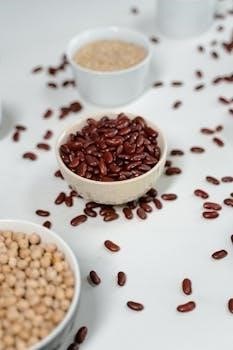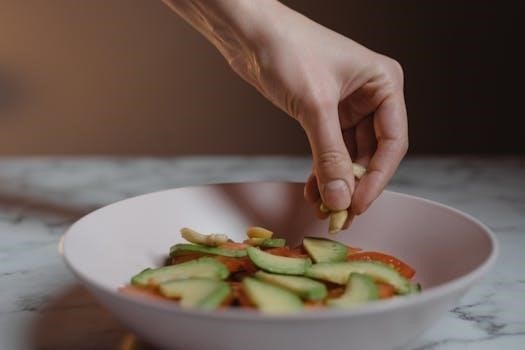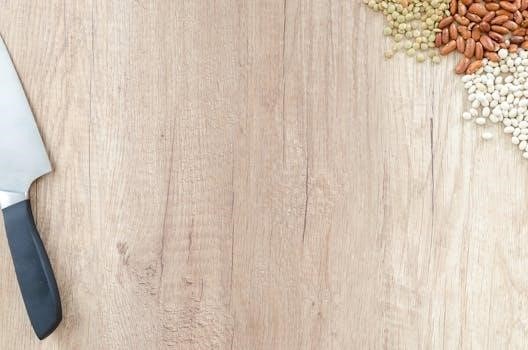Exploring high-protein‚ low-carb vegetarian diets involves leveraging plant-based protein sources like nuts‚ seeds‚ beans‚ lentils‚ and tofu․ These diets focus on minimizing carbohydrate intake while maximizing protein‚ promoting satiety and healthy nutrition from sources like quinoa and mushrooms․
Understanding the Basics of High-Protein Low-Carb Eating
High-protein‚ low-carb vegetarian eating is a dietary approach that emphasizes consuming substantial amounts of protein while significantly limiting carbohydrate intake․ This strategy aims to promote satiety‚ support muscle maintenance‚ and manage blood sugar levels‚ all while adhering to a vegetarian lifestyle․ The focus shifts towards plant-based protein sources such as legumes‚ tofu‚ tempeh‚ nuts‚ and seeds․ It’s crucial to prioritize whole‚ unprocessed foods rich in nutrients․ This dietary approach often necessitates careful planning to ensure adequate intake of essential nutrients that might be commonly found in animal products․ It is also important to understand the role of healthy fats in this approach‚ as they become a primary energy source when carbohydrates are restricted․ This diet often includes lots of vegetables․ This combination can lead to significant health benefits‚ including weight management and improved metabolic health․ The key is to balance protein‚ healthy fats‚ and limited carbohydrates while ensuring a diverse and nutritious intake․

Key Vegetarian Protein Sources
Key vegetarian protein sources include legumes‚ like lentils and chickpeas‚ tofu and tempeh‚ nuts and seeds․ These provide essential amino acids․ Dairy and eggs can be included for additional protein‚ depending on dietary preferences․
Legumes⁚ Lentils‚ Chickpeas‚ and Beans
Legumes‚ encompassing lentils‚ chickpeas‚ and various beans‚ are nutritional powerhouses crucial for high-protein‚ low-carb vegetarian diets․ These versatile plant-based foods offer a significant amount of protein per serving‚ making them excellent meat alternatives․ Lentils‚ for instance‚ are rich in both protein and fiber‚ aiding in satiety and digestion; Chickpeas are equally valuable‚ providing a hearty texture and protein content suitable for various dishes like salads‚ stews‚ and veggie burgers․ Beans‚ including black beans‚ kidney beans‚ and pinto beans‚ contribute substantial protein and fiber‚ and can be incorporated into diverse meals‚ from chili to tacos․ These legumes are also sources of essential nutrients‚ including iron‚ folate‚ and potassium․ They are easily incorporated into meal plans due to their availability and adaptability․ Their high fiber content helps regulate blood sugar‚ which is beneficial for those following a low-carb diet․ Legumes are truly the cornerstone of many high-protein vegetarian recipes․
Tofu and Tempeh
Tofu and tempeh‚ both derived from soybeans‚ are indispensable sources of protein in a high-protein‚ low-carb vegetarian diet․ Tofu‚ known for its versatility‚ is available in various textures from silken to firm‚ making it suitable for diverse cooking methods like grilling‚ stir-frying‚ and baking․ It readily absorbs flavors‚ making it a canvas for creative culinary explorations․ Tempeh‚ on the other hand‚ is made from fermented soybeans‚ offering a firmer texture and a nutty flavor․ It is often used in dishes like sandwiches‚ stir-fries‚ and as a meat substitute in hearty meals․ Both tofu and tempeh are complete proteins‚ meaning they contain all nine essential amino acids․ They are low in carbohydrates and provide a good source of iron and calcium․ They can be easily incorporated into various recipes‚ providing a substantial protein boost․ Their mild flavors allow for easy customization with different sauces and spices․ They are foundational ingredients in many plant-based recipes for those looking to reduce meat intake․
Nuts and Seeds
Nuts and seeds are nutritional powerhouses‚ offering a valuable source of protein and healthy fats‚ making them excellent components of a high-protein‚ low-carb vegetarian diet․ Almonds‚ walnuts‚ cashews‚ and pistachios provide not only protein but also essential nutrients like fiber‚ vitamin E‚ and magnesium․ Seeds like chia‚ flax‚ hemp‚ and pumpkin are packed with protein‚ omega-3 fatty acids‚ and fiber․ These versatile foods can be easily integrated into meals and snacks․ Add them to salads‚ yogurt‚ or smoothies for a protein boost and a satisfying crunch․ They can also be used in baking for extra texture and nutrition․ Be mindful of portion sizes‚ as they are calorie-dense․ Roasted or raw‚ nuts and seeds offer a convenient and delicious way to enhance your diet‚ providing sustained energy and supporting overall well-being․ They are crucial for those aiming to maximize protein intake while minimizing carbs․ Their diverse flavors and textures make them a delightful addition to any plant-based meal plan․
Dairy and Eggs (If Included)
For vegetarians who include dairy and eggs in their diet‚ these options can be significant contributors to a high-protein‚ low-carb eating plan․ Eggs are a complete protein source‚ offering all nine essential amino acids‚ making them a versatile and easily incorporated food․ Dairy products like Greek yogurt‚ cottage cheese‚ and hard cheeses provide substantial protein along with calcium and other essential nutrients․ These foods can be included in various meals‚ such as breakfast‚ lunch‚ or snacks․ Greek yogurt is particularly beneficial due to its high protein content and lower carbohydrate levels compared to regular yogurt․ Cheese‚ in moderation‚ can add flavor and protein to dishes․ It is crucial to select full-fat or low-fat varieties based on dietary preferences and goals․ Remember to consider portion sizes‚ especially for dairy products that may have higher calorie content․ Eggs can be prepared in numerous ways‚ making them a flexible option for any meal․ When choosing dairy and eggs‚ consider sources from pasture-raised or organic options for a more nutrient-dense selection․

Sample Meal Plan Ideas
Creating a high-protein‚ low-carb vegetarian meal plan involves thoughtfully combining plant-based protein sources like lentils‚ tofu‚ and nuts․ This ensures balanced nutrition and keeps meals both delicious and satisfying throughout the day․
Breakfast Options
For a high-protein‚ low-carb vegetarian breakfast‚ consider options that move beyond typical carb-heavy choices․ Start your day with a tofu scramble‚ packed with protein and customizable with various vegetables․ Alternatively‚ a hearty portion of Greek yogurt (if dairy is included) mixed with nuts and seeds offers a protein punch while keeping carbohydrates low․ Another great choice is a seed-based porridge made with chia or flax seeds‚ providing a good dose of protein and fiber․ If you enjoy eggs‚ an omelet filled with spinach and cheese (if included) is a simple and fast option․ You can also explore recipes that incorporate protein powder into smoothies with low-carb fruits and vegetables for a quick and convenient choice․ Remember to prioritize whole‚ unprocessed foods and watch out for hidden sugars in packaged items․ These options not only kickstart your metabolism but also keep you feeling full and energized until your next meal․ Prioritizing these protein-rich breakfasts will set the tone for a successful day of high-protein‚ low-carb eating․
Lunch Options
For a satisfying high-protein‚ low-carb vegetarian lunch‚ focus on combining protein-rich ingredients with plenty of fiber and healthy fats․ A hearty lentil salad with mixed greens‚ vegetables‚ and a lemon-tahini dressing is both nutritious and filling․ Another excellent choice is a tofu or tempeh “steak” served over a bed of spinach or other leafy greens․ You can also prepare a variety of vegetable-based soups‚ such as a creamy mushroom soup or a black bean soup‚ loaded with plant-based protein․ Consider a protein-packed Buddha bowl that includes chickpeas‚ avocado‚ and roasted vegetables for a balanced meal․ A substantial portion of cottage cheese (if dairy is included) with chopped vegetables and seeds provides a quick and easy lunch option․ Remember to choose whole‚ unprocessed foods and avoid excessive amounts of high-carb ingredients․ These lunch ideas will keep you energized and satisfied while adhering to your high-protein‚ low-carb plan․ By focusing on protein at lunch‚ you will avoid energy dips and stay full until dinner․
Dinner Options
For high-protein‚ low-carb vegetarian dinners‚ explore options that are both satisfying and nutrient-rich․ A hearty lentil and vegetable curry served with cauliflower rice is a great choice‚ offering a substantial amount of protein and fiber․ Tofu or tempeh stir-fries with plenty of non-starchy vegetables and a flavorful sauce can be prepared quickly and easily․ Consider a baked or grilled halloumi with roasted vegetables like bell peppers‚ zucchini‚ and onions for a protein-packed meal․ A black bean chili‚ loaded with spices and topped with avocado‚ is another excellent option․ Stuffed bell peppers with a mixture of quinoa‚ vegetables‚ and plant-based protein are both delicious and visually appealing․ A creamy mushroom pasta‚ using low-carb pasta alternatives‚ can be a comforting and fulfilling meal․ These diverse dinner ideas will help you enjoy a variety of flavors while meeting your high-protein‚ low-carb goals․ Prioritize whole foods for maximum nutritional benefits and keep portions in mind․ Always focus on protein content for sustained energy throughout the evening․

Recipe Examples
Discover a variety of high-protein‚ low-carb vegetarian recipes‚ including quick and easy meals and flavorful dishes‚ using ingredients like tofu‚ lentils‚ and various vegetables․ These options will help you stay on track with your dietary needs․
Quick and Easy High-Protein Vegetarian Recipes
For those seeking swift‚ nutritious‚ and high-protein vegetarian meals‚ several options stand out․ Consider a speedy tofu scramble with spinach and a sprinkle of nuts for a protein-packed start to your day․ Lentil soup‚ a versatile and quick choice‚ can be enhanced with spices and a dollop of Greek yogurt (if dairy is included)․ Chickpea salad sandwiches‚ using whole-grain bread or lettuce wraps‚ provide a satisfying and fast lunch․ For a simple dinner‚ try a quick stir-fry with tofu or tempeh and an assortment of low-carb vegetables‚ seasoned with your favorite herbs and spices․ These recipes emphasize efficiency without sacrificing protein content‚ and many can be customized with available ingredients․ Remember‚ meals focusing on speed do not have to lack in flavor or nutritional value․ Explore these simple‚ high-protein dishes to complement your dietary plan and save time in the kitchen․
Flavorful High-Protein Vegetarian Meals
Elevate your high-protein‚ low-carb vegetarian diet with recipes that burst with flavor․ Explore a vibrant Palak Paneer‚ a creamy spinach and cheese dish offering a delightful Indian culinary experience․ Create a hearty black bean chili with pulled mushrooms‚ a smoky and satisfying meal packed with protein and fiber․ Try stuffed peppers filled with a mixture of quinoa‚ lentils‚ and spices for a nutritious and flavorful option․ A flavorful lentil-based veggie burger‚ served on a lettuce bun‚ is another creative way to enjoy plant-based protein․ Don’t forget about tofu or tempeh marinated in flavorful sauces and baked or grilled to perfection․ These meals showcase that vegetarian cuisine can be both protein-rich and incredibly delicious․ Experiment with diverse spices‚ herbs‚ and cooking methods to create a range of exciting and satisfying high-protein vegetarian dishes that will keep you enjoying your meals․

Considerations and Tips
When adopting a high-protein‚ low-carb vegetarian diet‚ ensure adequate intake of iron‚ vitamin B12‚ calcium‚ vitamin D‚ and zinc․ Include diverse sources like beans‚ lentils‚ and tofu to meet your nutritional needs․
Ensuring Adequate Nutrient Intake
When embarking on a high-protein‚ low-carb vegetarian diet‚ meticulous planning is crucial to guarantee the consumption of all essential nutrients․ Plant-based diets can sometimes lack certain vitamins and minerals‚ necessitating careful food choices and potential supplementation․ It’s vital to pay close attention to iron intake‚ as plant-based iron is less readily absorbed than heme iron found in meat․ Combining iron-rich foods with vitamin C can enhance absorption․ Similarly‚ vitamin B12‚ primarily found in animal products‚ might require supplementation or fortified foods․ Calcium and vitamin D are also important for bone health‚ and incorporating calcium-rich plant sources or fortified alternatives is advisable․ Zinc‚ another mineral that can be deficient in vegetarian diets‚ can be obtained from nuts‚ seeds‚ and legumes․ A well-planned diet‚ with diverse protein sources and a focus on nutrient-dense foods‚ is key to maintaining optimal health and well-being․ Consulting a healthcare professional or registered dietitian can provide tailored guidance to address individual nutrient needs and dietary preferences․